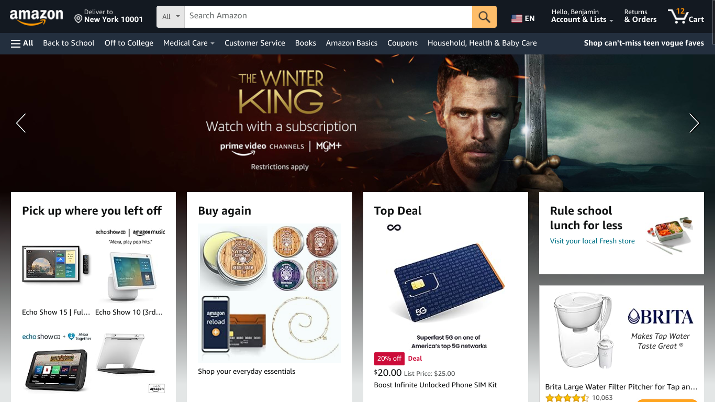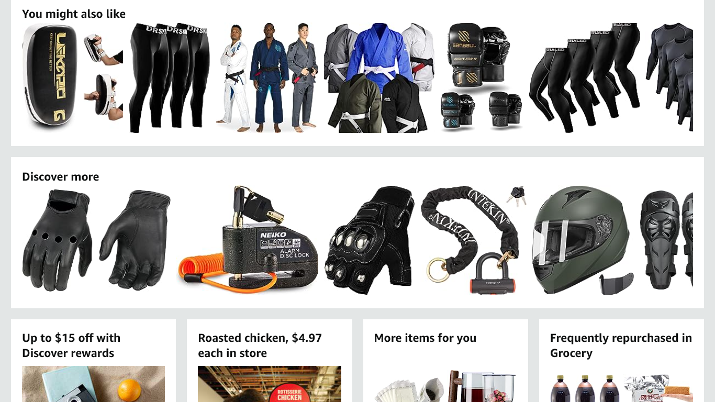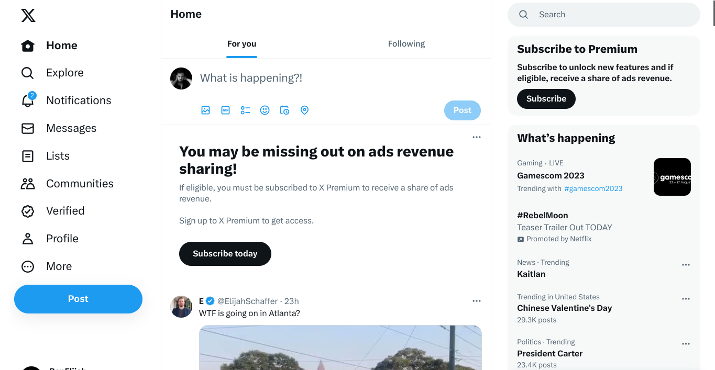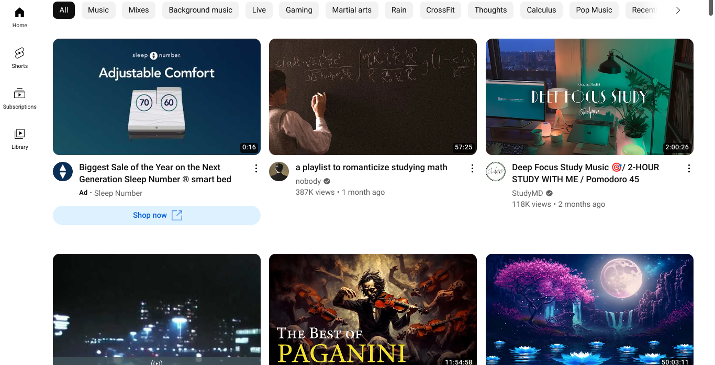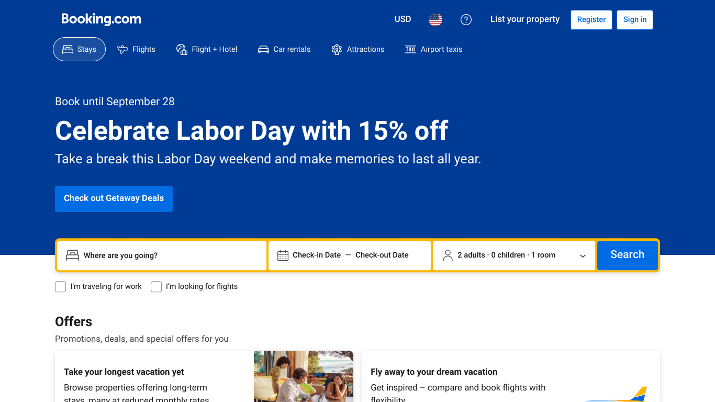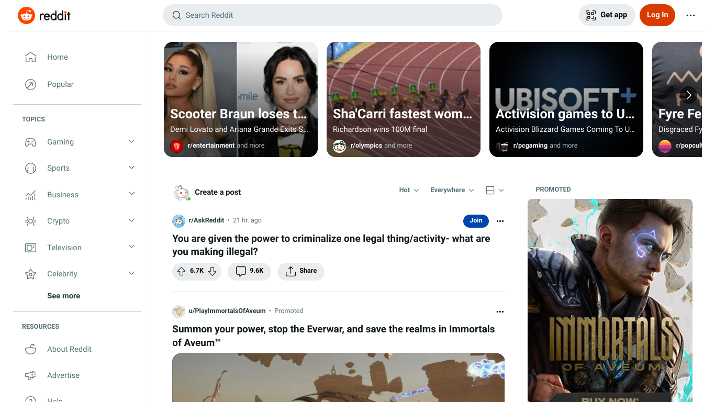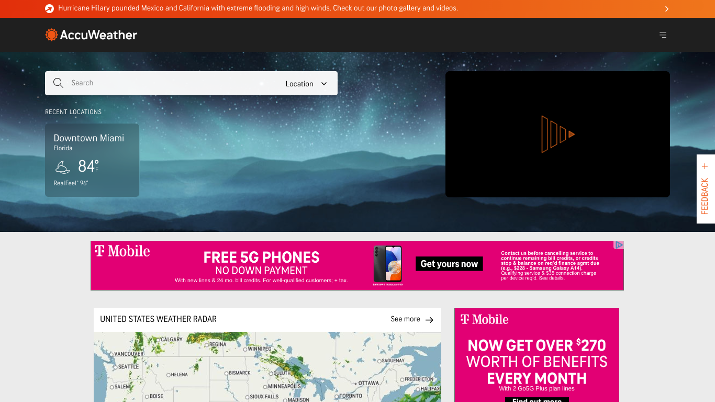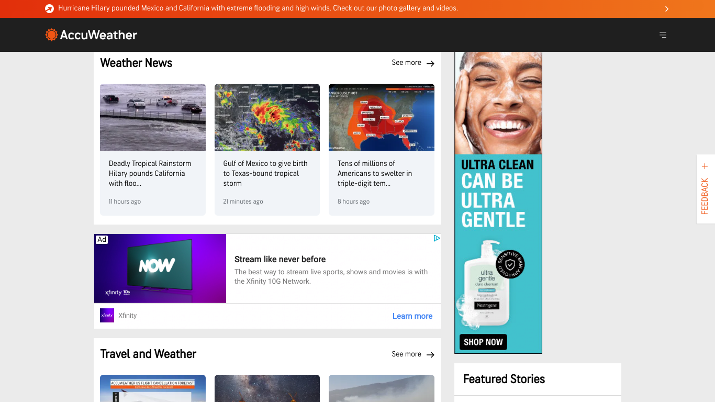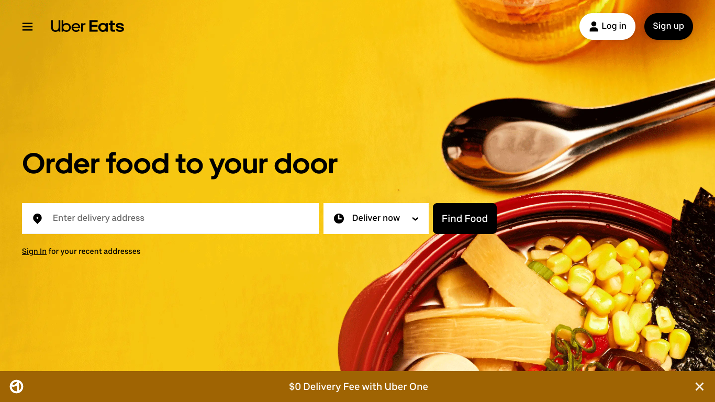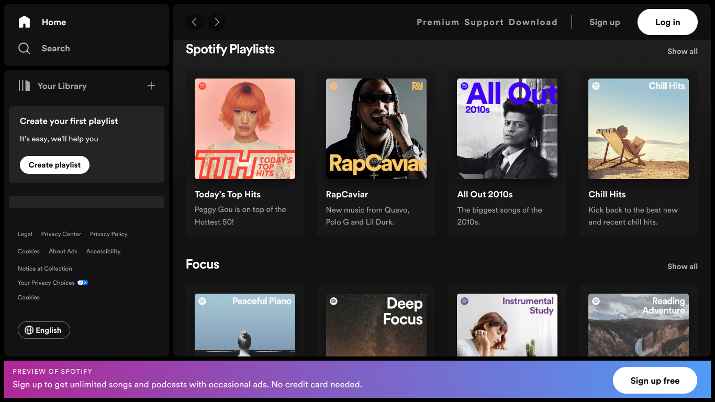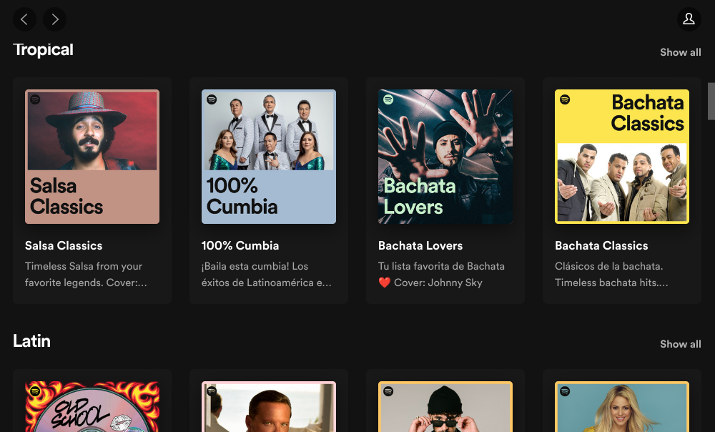Dynamic websites increase engagement and offer a more personalized experience to users, improving the user experience and increasing user retention.
In this article, I will give you 10 examples of dynamic websites and explain what makes each one dynamic.
To start, though, I will discuss what dynamic websites are, what sets them apart from static websites, and why you might want to build a dynamic website.
The short version: Dynamic websites generate a new file and webpage for each visitor, based on dynamic rules and factors. The top examples of dynamic sites include Amazon, Google, YouTube, Netflix, and AccuWeather. However, these websites are not suitable for all situations; sometimes, static websites are better.
Let’s read on to learn more.
Also Read:
Understanding Dynamic Websites
Photo by Tranmautritam, Pexels
Dynamic websites are websites that don’t display the same content to everyone. Instead, they display different content depending on who is browsing the website and depending on other factors such as the geographical location of the user.
That means that if you and your friend browse the same dynamic website, you may see two very different things. You may see different:
- Content
- Recommendations
- Languages
- Currencies
Also Read: What Is A Website Title?
Static vs Dynamic Websites
A static website displays mostly the same information to everyone who visits it. A good example would be a blog.
When you land on most blogs, you will see the same content as everyone else. The most recently published blog post will appear first on the feed, and the content in that blog post will be the same as what your friend sees.
This is called a static website. Most websites are static websites and show the same content – or at least the same core content – to everyone.
Landing pages are generally static as well. Landing pages may be sales pages promoting a specific product, and the elements – including the sales video, sales pitch, and the CTA button – will largely be the same for all visitors.
Dynamic vs Interactive/Engaging Websites
Just because a website isn’t dynamic, that doesn’t mean it isn’t engaging or interactive. The two are not the same thing – that is a common misconception.
A static website can be interactive and engaging. You can have call-to-action buttons, pop-ups, flashing elements, automatically playing slides or videos, and a lot more!
However, if the core content is the same, I would still personally consider it a static website.
Just because it shows different ads to different people, for example, doesn’t mean it is a dynamic website by definition.
Check Out: Website Title vs Article Title
When Should You Create a Dynamic Website?
Dynamic websites are best for certain kinds of sites that require more personalization than standard websites.
A blog, landing page, or portfolio website doesn’t really need to be dynamic. You just need to make sure that it is engaging and interactive.
You should also ensure that it is easy to navigate, provides a smooth user experience, and is optimized for mobile devices.
However, if you have an ecommerce website, for example, you could benefit from making it dynamic.
It is possible to have a static ecommerce website that displays the same products to everyone. If you have a small ecommerce store with a limited range of products, this is likely the kind of website you have.
The larger and more complex your site gets, though, the more you would benefit from offering a dynamic experience. By showing people products that are most suited to them, you will increase your sales rate and increase your bottom line.
You can do that by displaying products based on location or by providing product recommendations based on previous purchases or browsing history.
Other types of sites that you might want to make dynamic include:
- Sites that stream music, play movies, or offer some other kind of streaming on demand
- Educational sites
- Social media platforms
- Forums
Explore: Website Title Examples & Ideas
Benefits and Drawbacks of Dynamic Sites
Photo by Pixabay, Pexels
There are many benefits of dynamic sites. On the one hand, by offering a more personalized user experience, you can increase your bottom line, get more sales, improve customer retention rates, boost customer satisfaction, and a lot more.
For example, by showing customers products that are tailored to their interests, you are more likely to get them to buy a product. If you show them products they are not interested in, they are less likely to buy them.
If you provide an educational site or a site that streams some type of content, displaying personalized suggestions will cause users to spend more time on the site. If your business model relies on advertising, this will increase your revenue.
If it relies on monthly membership subscriptions, you will increase customer retention. If people are enjoying their time on your site or app, they will be less likely to cancel their subscriptions, because they will be getting more value out of it.
On the other hand, dynamic sites are also a lot more expensive to build. A static site pulls the same HTML file from the server and displays it to every visitor.
This means that it requires less coding and fewer resources.
Meanwhile, dynamic sites require more complicated programming on the back end. You can’t have a single HTML file to show everyone.
Instead, you need complex coding and large databases of different objects, products, data, etc. to show different people. You also need complex algorithms that decide which objects are shown to which people.
With dynamic sites, a new webpage is generated each time, based on dynamic rules that determine which data or items from the database will be shown. That is what allows different products or items to be displayed to different people.
Not only does it cost a lot more to build, but it also requires a lot more resources to maintain. You need a larger and more skilled team and/or more expensive tools or plugins.
Therefore, it’s important to weigh the pros and cons of building a dynamic website. Most small websites don’t need to be dynamic – it’s an unnecessary expenditure and too much infrastructure to maintain, without enough benefit to justify it.
As you will see in this list, most of the top dynamic website examples are pretty big names, such as Amazon, YouTube, and Google. These websites have the resources to be dynamic.
Even without being a full-fledged dynamic site, though, you can code your site with Java or another programming language to display different information to different people.
For example, you can set up dynamic rules (such as if, if else, and else if rules) to determine which price is displayed in the shopping cart, based on factors such as whether the customer is a premium customer or has bought a certain amount of items to qualify for a discount.
With that introduction, let’s get into things.
Also Read:
Dynamic Website Examples [Top 10 Examples]
1. Amazon
Amazon is perhaps one of the best and most well-known examples of dynamic websites.
When you visit Amazon, you won’t see the same products on the homepage as others. Everyone will get tailored recommendations based on factors such as what they have previously purchased or browsed on the site.
As you can see in the following screenshot, since I showed an interest in martial arts products, I am now being shown products such as boxing gloves and martial art uniforms. I also bought some biker products, which is why I am being shown biker gloves, helmets, shin pads, and motorcycle wheel locks.
Even if you never bought anything on Amazon or used it before, you will get recommendations based on your location – for example, if you are not in the US, you will be shown products that ship to your country.
Check Out:
2. Twitter
Twitter (now rebranded as “X” by Elon Musk) is another great example of a dynamic website. When you browse Twitter, you will not see the same tweets that others see.
Here are some of the things that determine what you will see:
- People you follow: You may be following different people and thus see different posts than your friend.
- Your location: Twitter will show you trending topics in your country, which may be entirely different from the trending topics in another country.
- Your previous browsing history and activity: You will see trending posts about hashtags and topics you have previously shown interest in.
There are likely many other factors that play a role in Twitter’s algorithms, and they are beyond the scope of this article.
This brings us to another topic, which is the idea of bias and how it plays a role on social media (or how social media affects it).
You are likely to interact with accounts and posts that you are politically aligned with – for example, if you interact with conservative posts, Twitter will show you posts from conservative politicians and thinkers.
This means you are less likely to see ideas from people with opposing viewpoints.
However, that is a topic for another day – let’s not go too far off on a tangent.
Also Read:
3. Google
Google is dynamic in many ways.
First of all, it provides personalized results in the search results, based on factors such as time and location.
If you ever traveled to another country or even another city, you may have noticed that you see different results based on your location.
For example, if you travel to France, and you search for a specific product, you will see results from French ecommerce stores. Google does this for convenience – consumers in France can purchase from those websites easily, as they ship locally without extra fees.
It’s not limited to products. Let’s say you search for the answer to a legal question.
If you are in the US, you will be shown results from US-based sites that cover US law. Meanwhile, if you are in France, you will likely see results that talk about French law, which may differ greatly from US law.
When it comes to local searches, things get even more granular. Depending on where you are in a city (Brooklyn vs Manhattan, for example), you may see different Google My Business profiles show up at the top of the search results.
When you start typing a search phrase into Google, you may notice that Google has auto-complete suggestions to help you finish your search.
For example, let’s say you start typing “how to learn coding.” Google may give you several suggestions:
- How to learn coding Java
- How to learn coding Python
- How to learn coding for free
- How to learn coding with no experience
- How to learn coding online
These suggestions are not the same for everyone. Rather, they are dynamically generated and based on your previous search history.
If you previously expressed an interest in Java, Google may suggest the first of the options I mentioned above. If you were more interested in Python, it might suggest the second.
Explore:
4. YouTube
YouTube will display videos based on your previously expressed interests, as well as other factors such as your location.
The videos displayed on YouTube, both on your homepage and in your suggested video feed when watching a video, will depend on the videos you already watched, topics you searched for, and channels you subscribed to.
Even if you log onto YouTube from a new computer, in incognito mode, you will likely see videos related to your location. For example, in the US, you might see videos that cover US news.
Not only that, but the ads you see will also vary based on your interests, location, and language.
Let’s say you watch a music video in Spanish – you may see an ad in Spanish. Or, if you travel to Mexico, you will notice that you suddenly start seeing ads in Spanish.
YouTube is an excellent example of a dynamic website, because no two people will get the same recommendations.
Explore:
5. Netflix
Netflix is another good example of a dynamic website.
First of all, the films, movies, and series available will depend on regional restrictions. So, you might see certain films that are not available in another country due to licensing agreements.
Even more than that, however, Netflix will display different recommendations based on what you previously watched.
For example, if you always watch sitcoms, Netflix will recommend sitcoms. If you are a horror fan and love watching horror movies, Netflix will start recommending horror films.
That is why Netflix lets you set up different profiles on one account – it’s so different people can get their own personalized suggestions and keep track of their viewing history.
Also Read:
6. Booking.com
Booking.com is a hotel and lodging reservation site. You can book hotels, apartments, and more.
Although it’s mostly known for accommodation, you can also book flights and other travel necessities, such as tours.
Booking.com is a dynamic website, because it shows different information to different people.
Depending on your location, you will notice the currency and even language changing automatically.
You can always change the currency or language, but Booking automatically detects your location and displays the most relevant currency or language accordingly.
You may also get your recommendations based on the hotels you booked on the site. For example, if you book a hotel in London, Booking may suggest tours that show you around London.
Meanwhile, another person won’t necessarily see those recommendations.
Check Out:
7. Reddit
Reddit is a dynamic site, because the content you will see there will depend on numerous factors.
The first is the subreddits you have subscribed to and joined. You will get a personalized feed with content from subreddits you joined and people you follow.
You will also get recommended posts from subreddits that discuss topics similar to subreddits you have already joined. These posts are personalized for you.
Finally, you will see recommended posts based on your location. For example, if you live in New York, there is a good chance Reddit will recommend posts from the NYC subreddit.
Explore the best alternatives to Reddit here.
8. AccuWeather
AccuWeather is one of the most popular weather forecasting apps. When you visit AccuWeather, either the desktop site or the mobile app, it will show you a map and weather forecasts for your location.
It will also display your most recently viewed locations.
Furthermore, it will display weather-related news based on your location. If you are in the US, it will show you news updates about hurricanes, tornadoes, snowstorms, and other natural disasters in the US you should be aware of.
Meanwhile, if you are in another country, such news might not be relevant to you, so you will see local news instead.
Explore:
9. Uber Eats
Uber Eats is a website and application that allows you to order food, groceries, and medicine from restaurants, convenience stores, and pharmacies near you.
The restaurants you will see will depend on your location. Your distance from a specific restaurant will determine whether it will be shown on the app.
Even if it is shown, the order in which restaurants and eateries are shown will depend on your distance from them. The delivery cost for each restaurant will also update dynamically based on your location.
Not only that, but Uber Eats will recommend restaurants, eateries, and products/meals based on what you like.
Thus, Uber Eats is a very dynamic website. You can’t expect to see the same exact things as your friend in another neighborhood.
Find out more sites like Uber Eats in this post.
10. Spotify
Finally, we have Spotify. Spotify is a music streaming service that lets you stream music, podcasts, and more on demand.
Spotify will recommend albums and playlists based on your previous listening history. If you listen to a lot of rap, you can expect Spotify to recommend additional rap music.
Spotify also curates albums and “specialized mixes” for each user, which usually includes songs they have frequently listened to as well as similar songs from the same artists or genres. These specialized mixes are different for every person.
Since I enjoy listening to a lot of Latino music, Spotify always recommends new Cumbia, Salsa, Bachata, and Reggaeton albums and tracks, as you can see in the screenshot above. However, it may not recommend these genres to you.
Explore the best alternatives to Spotify here.
To Sum Up
There you have it – some of the best examples of dynamic websites. You probably use many of them on a regular basis, so you are familiar with dynamic websites – even if you didn’t know it.
As you can see, dynamic websites have a lot of benefits, as they provide a much better and personalized user experience. On the other hand, they are more expensive to build and usually require the collection of personal data to provide the personalized results.
Therefore, it’s important to weigh the pros and cons before deciding to create a personalized website.

Ben Levin is a Hubspot certified content marketing professional and SEO expert with 6 years of experience and a strong passion for writing and blogging. His areas of specialty include personal finance, tech, and marketing. He loves exploring new topics and has also written about HVAC repair to dog food recommendations. Ben is currently pursuing a bachelor’s in computer science, and his hobbies include motorcycling, Brazilian Jiu-Jitsu, and Muay Thai.


